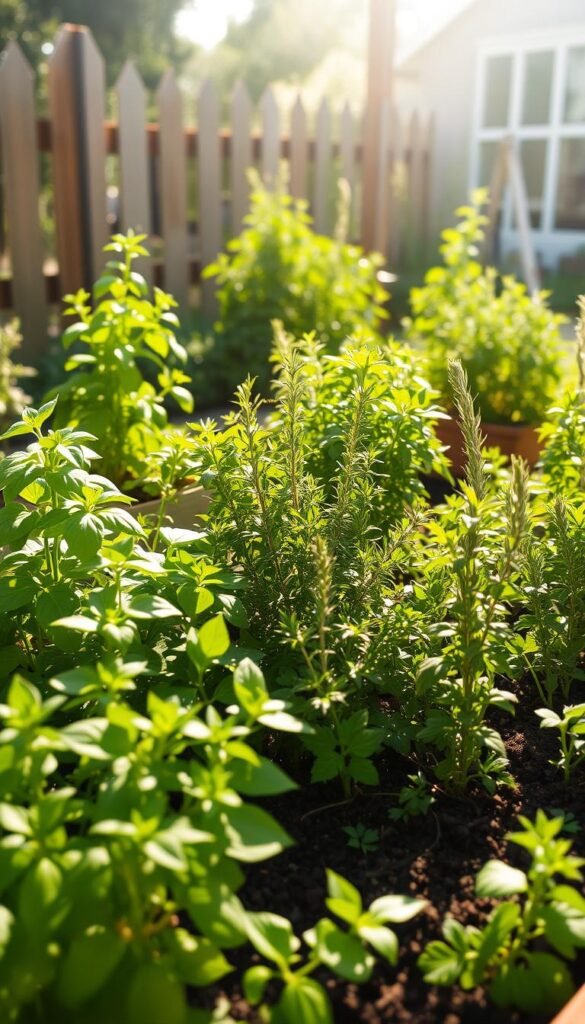Imagine stepping outside your door or onto your windowsill to snip fragrant leaves for tonight’s dinner. Growing your own flavorful plants is simpler than you think. Many varieties thrive with basic care—just a pot, sunlight, and occasional watering. These plants reward you quickly, often ready to harvest the same day you bring them home.
Starting a small garden unlocks a world of fresh flavors. You’ll ditch dried spices from jars and experience how vibrant, homegrown leaves elevate everyday meals. No fancy tools or green thumb required—just consistent sunlight and well-draining soil keep most varieties happy. Regular trimming actually helps them grow bushier, meaning more ingredients for your recipes.
This guide reveals seven resilient plants that practically grow themselves. You’ll learn how to create ideal conditions, whether you’re working with a patio planter or countertop containers. Discover how nurturing these greens becomes a calming ritual that saves money and reduces grocery trips.
From boosting your cooking game to cutting food waste, fresh-picked flavors transform your kitchen routine. Let’s explore how anyone can cultivate these versatile plants—no backyard needed.
Getting Started with Your Kitchen Herb Garden
Transform any corner of your home into a fresh flavor factory with minimal effort. Whether you’re working with a sunny ledge or a compact balcony, success begins with smart planning. Let’s break down the essentials for creating your personal green oasis.
Choosing the Ideal Space
Most culinary plants crave 6-8 hours of daily sunlight. South-facing windows work best indoors, while patios and balconies suit outdoor setups. No yard? No problem. Many urban gardeners thrive using creative container solutions like wall pockets or stacked planters.
Essential Supplies and Tools
Start simple with these basics:
| Item | Purpose | Budget Option |
|---|---|---|
| Containers | Root growth & drainage | Recycled cans |
| Potting mix | Nutrient delivery | DIY compost blend |
| Pruners | Healthy growth | Kitchen scissors |
Proper drainage prevents soggy roots—drill holes in reused containers if needed. For detailed setup ideas, explore this guide to thriving kitchen gardens. Remember: More sunlight means bolder flavors!
Why Grow Herbs in Your Kitchen Garden?
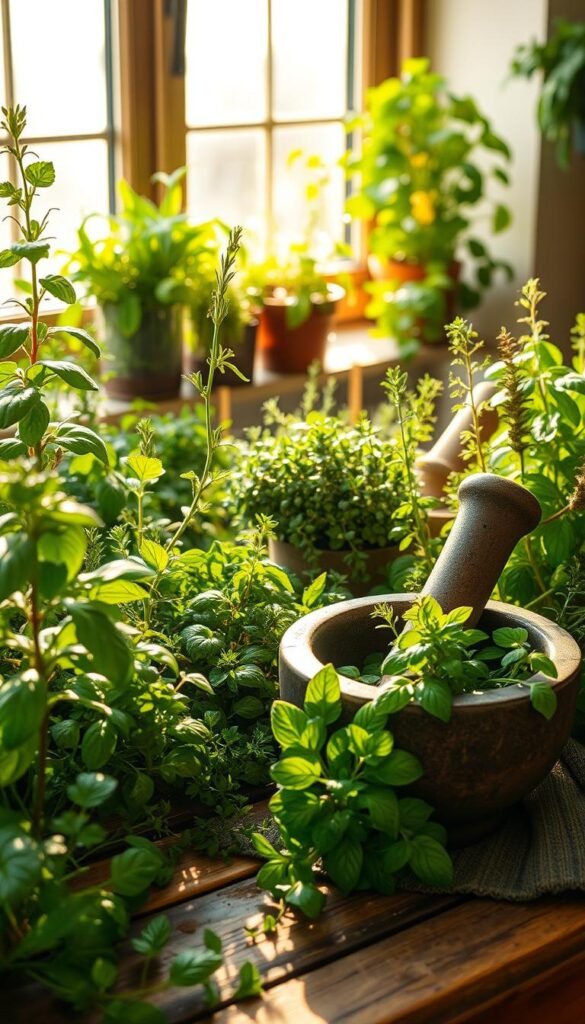
Picture adding garden-fresh ingredients to meals while saving money and boosting wellness. Cultivating your own greens offers perks that go beyond convenience—it’s a lifestyle upgrade anyone can achieve.
Health, Flavor, and Cost Benefits
Freshness pays dividends. Store-bought bundles often wilt before use, costing $3-$5 each. With live plants, you snip only what’s needed—no more tossing slimy basil packs. Try rosemary-infused olive oil or minty summer drinks without supermarket markups.
Homegrown varieties pack more punch. Studies show just-picked leaves retain 30% more antioxidants than store versions. Sprinkle thyme on roasted veggies or blend cilantro into salsas for vibrant, nutrient-rich dishes.
Gardening becomes self-care. Tending greens lowers stress hormones—one University of Washington study found 30 minutes of plant care reduced cortisol levels by 15%. Plus, watching seedlings thrive sparks joy that frozen herbs never could.
Your cooking transforms too. Imagine upgrading weeknight pasta with basil picked minutes before serving or garnishing soups with parsley from your sill. These small touches turn simple meals into restaurant-worthy plates.
Best Beginner-Friendly Herbs for Kitchen Gardens
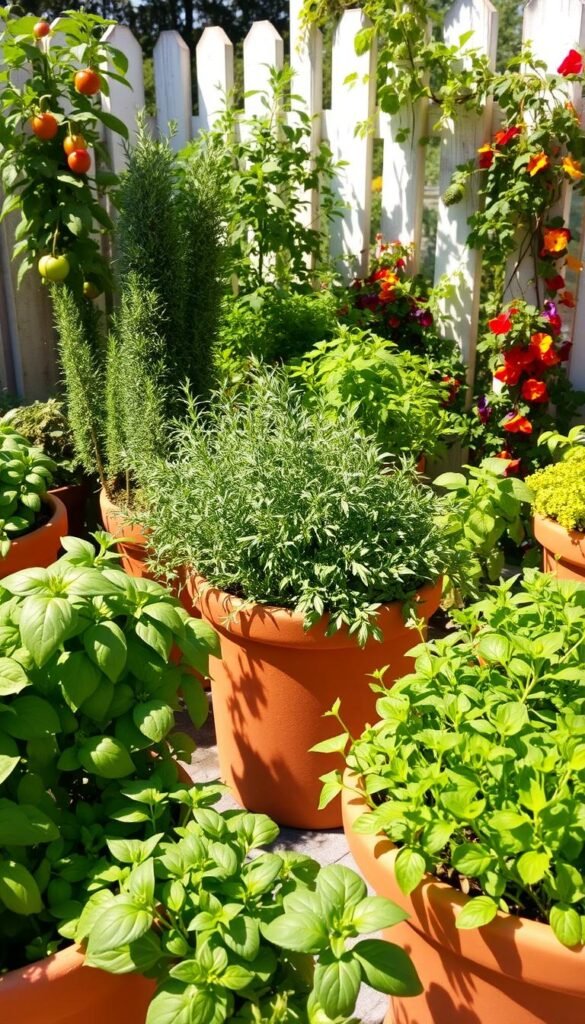
Unlock fresh flavors right at your fingertips with these resilient plants. Each variety offers unique perks—from instant recipe upgrades to low-maintenance care. Let’s explore seven superstar greens that thrive in small spaces.
Basil loves warmth and sunshine, producing aromatic leaves perfect for caprese salads. Mint thrives in containers (it’ll take over gardens otherwise), ideal for mojitos or fruit salads. Parsley’s mild flavor enhances soups and sauces, while thyme’s earthy notes elevate roasted veggies.
| Plant | Sunlight | Water | Recipe Star |
|---|---|---|---|
| Oregano | 6-8 hours | Weekly | Pizza sauces |
| Cilantro | 4-6 hours | Every 3 days | Guacamole |
| Chives | Partial shade | When dry | Egg dishes |
Start with plants matching your climate. Mediterranean varieties like rosemary crave heat, while parsley grows well in cooler areas. Prioritize ones you’ll actually use—if you hate dill pickles, skip it!
Most greens need well-draining soil and regular trimming. Snip mint stems above leaf nodes for bushier growth. Pinch basil flowers to prolong leaf production. With these simple tricks, you’ll harvest flavors that outshine store-bought jars.
Planning Your Herb Garden Layout
Designing your green space requires strategy. Group varieties with matching needs—like rosemary and thyme that prefer drier soil—to simplify care. Separate fast-spreading types like mint into individual pots to avoid takeover. Labels prevent mix-ups between lookalikes such as flat-leaf parsley and cilantro seedlings.
Raised Beds vs. Containers
Raised beds excel for permanent setups. Their divided sections keep oregano from tangling with chives, while deep soil suits dill’s long roots. Use cedar or composite materials for lasting durability. Compartmentalized designs let you rotate crops yearly.
Containers shine in small areas. Clay pots and fabric grow bags adapt to patios or fire escapes. They’re ideal for renters or those testing low-commitment container setups. Just ensure drainage holes to prevent waterlogged roots.
| Feature | Raised Bed | Container |
|---|---|---|
| Space Use | Permanent footprint | Portable |
| Soil Control | Custom blends per section | Individual mixes |
| Mobility | Fixed location | Sunlight chasing |
Maximizing Sunlight and Drainage
Position taller plants like sage northward to avoid shading basil. Morning light boosts flavor in leafy greens—aim for 6+ hours daily. Elevate pots on stands to improve airflow and drainage.
Mix perlite into potting soil for faster drying. Add gravel layers under raised beds to prevent pooling. Test drainage by watering empty pots—if puddles linger past 10 minutes, adjust your soil mix.
Expert Tips for Planting and Growing Herbs
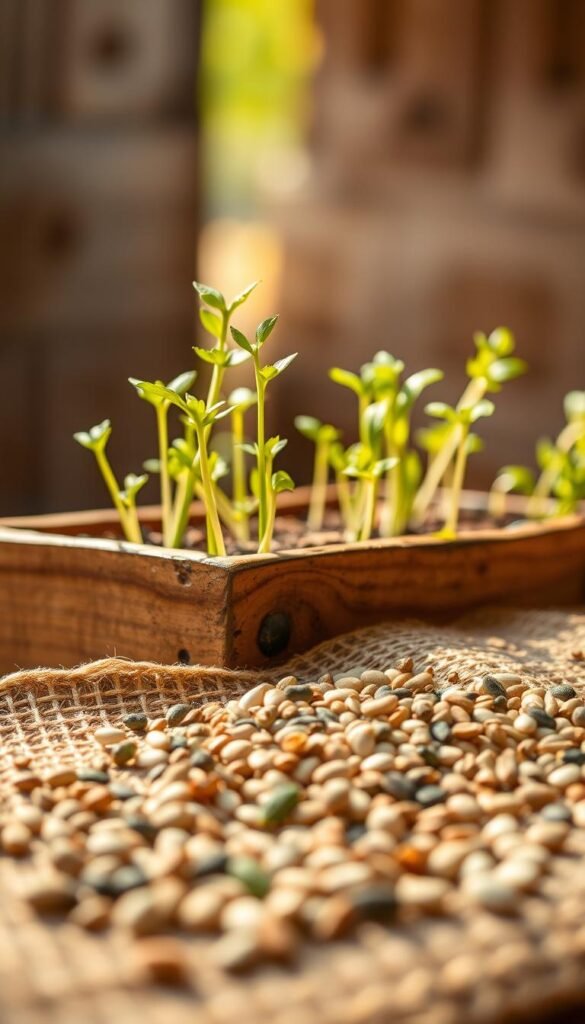
Mastering herb cultivation begins with smart planting choices. Tender-stemmed varieties like basil sprout quickly from seeds, while woody types like rosemary grow better from cuttings. Understanding these differences helps you avoid frustration and wasted time.
Seed starting vs. nursery plants: Seeds cost less and offer unique varieties, but transplants let you harvest sooner. Consider this comparison:
| Method | Cost | Time to Harvest |
|---|---|---|
| Seeds | $2-$5 per packet | 6-10 weeks |
| Transplants | $4-$8 per plant | 2-4 weeks |
Start seeds indoors 8 weeks before your last frost date. Soak parsley or cilantro seeds overnight to speed germination. Use seed trays with drainage holes and keep soil moist—not soggy—until sprouts appear.
When moving plants outdoors, harden them gradually. Expose seedlings to sunlight for 30 extra minutes daily over a week. This prevents leaf burn and shock. Always check roots before transplanting—gently loosen any circling ones to encourage outward growth.
Boost soil health with perlite or vermiculite for drainage. Mix in compost for nutrients, especially if reusing containers. Watch new growth closely: yellow leaves often signal overwatering, while stunted stems suggest poor root development.
Caring for Your Herbs: Watering, Feeding, and Maintenance
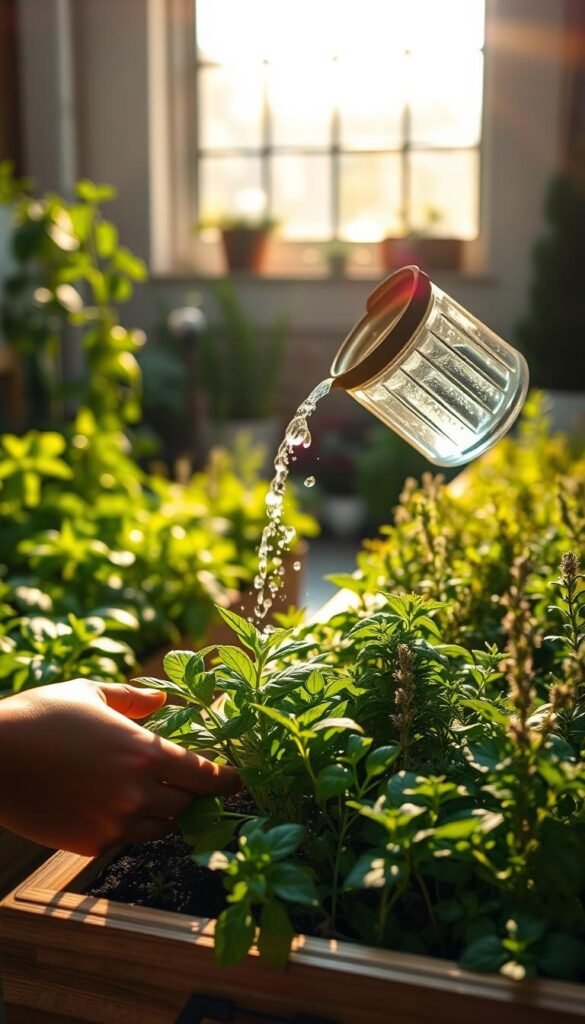
Keep your green allies thriving with simple care routines that match their natural rhythms. Understanding each plant’s preferences prevents common pitfalls while boosting flavor and growth. Let’s explore how to maintain vibrant, productive plants through smart hydration and nourishment.
Watering Guidelines for Different Herbs
Mediterranean varieties like rosemary prefer neglect over pampering. Let their soil dry completely between waterings—test by sticking your finger 2 inches deep. Tender-leafed basil and mint crave consistent moisture. Water when the top inch feels crumbly, usually every 3-4 days.
| Herb Type | Water Frequency | Signs of Thirst |
|---|---|---|
| Woody (rosemary) | Every 10-14 days | Leathery leaves |
| Tender (parsley) | Twice weekly | Drooping stems |
Morning watering reduces evaporation and mildew risks. Always aim at the soil line, not leaves. Container plants dry faster than ground ones—check them daily during heatwaves.
Organic Fertilizing Techniques
Feed your plants naturally with compost tea every 4-6 weeks. Steep aged compost in water for 48 hours, then strain. This liquid gold provides nutrients without chemical burns. For mint and other heavy feeders, mix worm castings into soil each spring.
Prune regularly to encourage bushiness. Snip mint just above leaf nodes using clean scissors. Remove flower buds from basil to prolong leaf production. Rotate pots quarterly for even sun exposure—your plants will reward you with lush growth.
Watch for yellowing leaves, which often mean overwatering. Crispy edges suggest dehydration. Adjust care with seasons: reduce watering in winter, increase airflow in humid months. With these habits, your green partners will flourish year-round.
Understanding Your Herbs’ Sunlight and Soil Needs
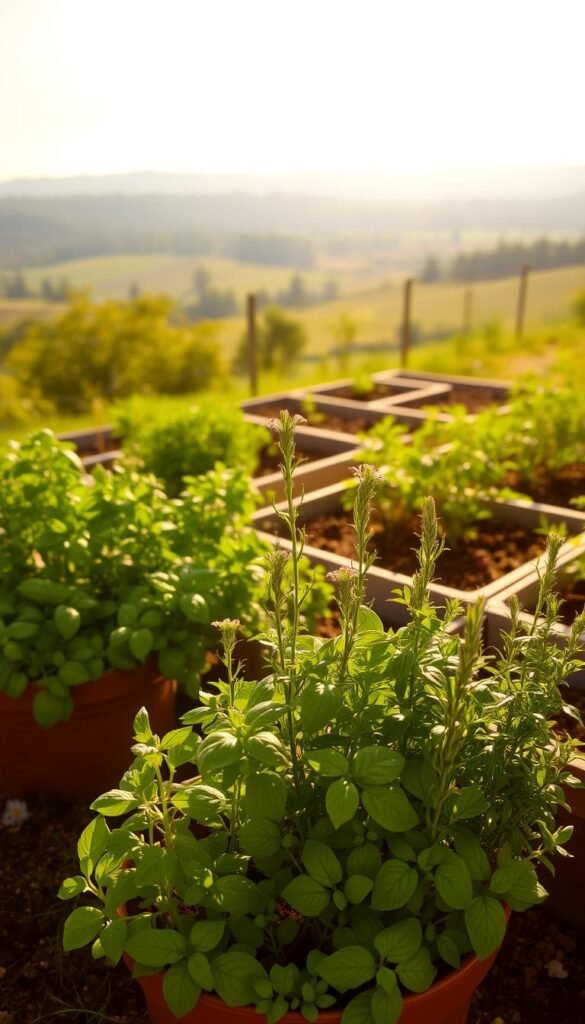
Light and earth form the foundation of every thriving herb garden. Most varieties need 6-8 hours of direct sun daily—think of it as their daily multivitamin. South-facing windows work best indoors, but don’t panic if your space gets less light. Modern solutions like LED bulbs can fill gaps when nature falls short.
Watch for warning signs: spindly stems or yellowing leaves scream “more sunshine!” Mediterranean types like rosemary show distress through brittle texture, while basil droops dramatically. Rotate pots weekly to ensure even exposure—your plants will grow fuller instead of leaning like sun-starved acrobats.
| Herb | Light Needs | Soil Preference |
|---|---|---|
| Thyme | Full sun | Gritty mix |
| Mint | Partial shade | Moist & rich |
| Parsley | 4-6 hours | Nutrient-dense |
Build your soil like a five-star buffet. Blend organic potting mix with compost at a 1:4 ratio—this creates loose, crumbly texture that roots adore. Add perlite if water pools on the surface. Test drainage by timing how fast moisture exits container holes; aim for 30-second drainage.
Artificial lighting? Easy fix. Use full-spectrum bulbs 6 inches above plants for 12-hour cycles. Pair timers with existing lamps to mimic natural rhythms. Remember: Healthy roots mean flavorful leaves. Get these basics right, and your green companions will reward you with nonstop growth.
Beginner-Friendly Tips for Harvesting Your Herbs
Your herb garden becomes most rewarding when you harvest like a pro. Start snipping leaves the day you bring plants home—they’re ready to elevate meals immediately. Regular trimming keeps growth vigorous, especially when you follow each variety’s preferences.
Morning harvests capture peak flavor. Essential oils concentrate overnight, making leaves taste boldest before afternoon heat. Use clean scissors or fingertips to avoid tearing stems. Always cut above leaf nodes—this signals plants to branch out instead of going leggy.
| Herb | Technique | Frequency |
|---|---|---|
| Basil | Pinch top leaves | Weekly |
| Mint | Snip stems | Every 3 days |
| Parsley | Trim outer stems | Biweekly |
| Chives | Cut base at 6″ | When tall |
For basil, remove flower buds to redirect energy into leaf production. Mint grows faster when you harvest often—those trimmings make perfect iced teas. Parsley rewards patience: let inner stalks mature while using outer ones first.
Store cuttings in damp paper towels inside airtight containers. Most stay fresh 5-7 days this way. Freeze extras in ice cubes for winter soups. Remember: frequent cutting isn’t cruel—it’s how you build lush, productive plants!
Troubleshooting Common Herb Garden Issues
Even resilient plants face challenges—here’s how to keep yours thriving. Yellow leaves often signal overwatering, while spindly stems scream for sunlight. Most problems have simple fixes once you spot the clues early.
Natural Pest Solutions
Neem oil tackles aphids without harsh chemicals. Mix 1 teaspoon with water and spray leaves weekly. Basil and mint naturally repel flies—plant them near vulnerable greens. Wipe dusty residue off rosemary to prevent spider mites.
Managing Rambunctious Growers
Mint’s enthusiastic roots need confinement. Use separate containers with drainage holes to stop underground takeovers. Prune weekly to maintain shape and airflow. Avoid planting aggressive varieties near delicate parsley or thyme—they’ll hog nutrients.
Check soil moisture before watering. Soggy earth suffocates roots, while bone-dry dirt stresses plants. Rotate pots monthly for balanced growth. With these tweaks, your garden stays lush and productive year-round.

